Providing an Omnichannel Customer Experience

This post is also available in:
![]()
![]()
![]()
![]()
Omnichannel has been a buzzword in the retail and service industries for over a decade, but how many people genuinely understand what it means? While its origins date back to the early naughties, omnichannel didn’t impact purchasing power and customer relationships until 2010. However, even when 2010 arrived, most people didn’t know what to do with it even though the indications looked to favour the omnichannel model. Even now, some still question whether omnichannel customer experience is worth the time and effort required to achieve it.
Multichannel vs Omnichannel
Even now, some people confuse omnichannel and multichannel, or worse, assume they’re the same thing. A multichannel approach provides several channels through which people can buy products and book services. However, omnichannel integrates all channels in a unified customer experience and journey. Right from initial contact to aftersales care.
Multichannel has been around for many years. From the widespread use of the telephone, retailers and service providers exploited it for the ease of access it gave their customer and clients. Then came the internet, mobile internet, search engines, and social media. Multichannel marketing and service is a segregated model; it’s about using every channel to reach potential customers, but without communication between them. There is no guarantee of receiving the same level of service or even the same product through diverse channels.
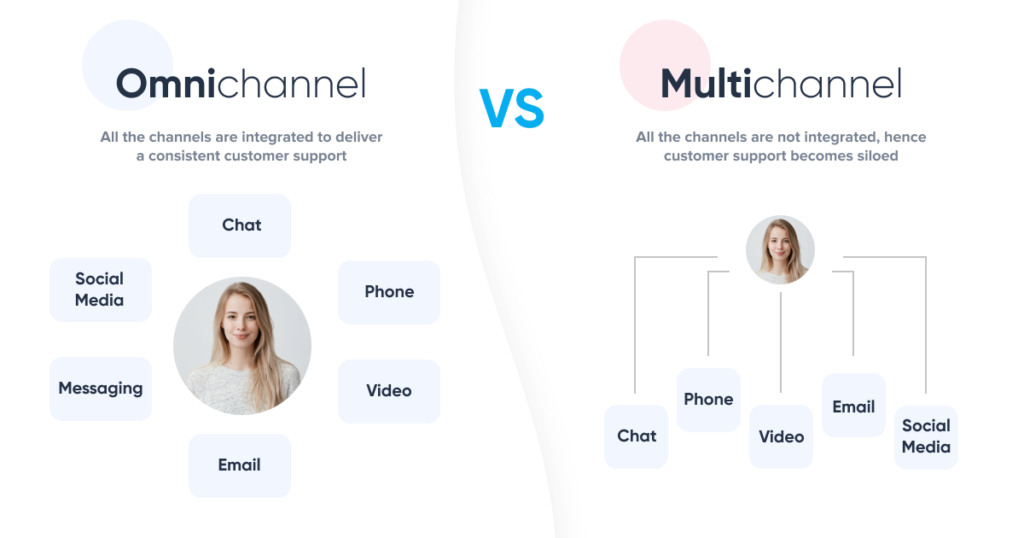
While omnichannel customer experience and multichannel marketing can work in tandem, they are not the same. They do not achieve equal measures of success in gaining and maintaining customers or loyalty. In some cases, omnichannel and omni-digital terms are used synonymously, but there are subtle differences when physical premises and stores are involved.
What is Omnichannel Customer Experience?
“An Omnichannel Customer Experience is a seamlessly integrated and synchronous series of touchpoints on a customer journey that puts the customer or client in charge of their buying process – how, when, and where they want.”
Dr. Edda Blumenstein – beOmni.is
Omnichannel customer experiences encompass everything from the initial awareness of a company’s product or service all the way to engendering customer loyalty and engaging client advocates. This means that every aspect of a customer journey should filter through a core integration system. One that takes a client from their first glimpse of a Facebook ad, through the purchasing process, customer service, aftersales care, and eventually to rewarding clients who advocate for them. Customer Service could be a touchpoint either before or after the purchasing process, so it’s best to position it at both points on your customer journey estimations.
Why is Omnichannel Structure Important
“People don’t wake up in the morning and decide ‘I will use my phone for this purchase and my laptop for something else.’
They might do part of what they need on their commute, on the bus or tube, with their mobile. They might then continue the process on their laptop or PC over lunch. Perhaps they even finish their business by collecting an item from the store or having a haircut on their way home.”
Dr. Edda Blumenstein – beOmni.is
A Smartphone is an excellent tool for mobile access to your booking or purchasing history or tracking your packages, or making an appointment. However, sometimes, you need to get a bigger picture (literally). You need more details or to compare multiple screens to get the best deal.
When customers want to switch between access points, they don’t want to reproduce every step in their purchasing journey to reach the same point; that’s just pointless and time-consuming.
A comprehensive structure encompassing all touchpoints between the customer and your business is vital to providing an omnichannel experience. Without a comprehensive framework, there is no way to maintain a unified customer experience, which is the entire point of an omnichannel strategy. A central data repository, collecting customer details from all input channels, then collating them into customer identifiers, is crucial. The ability to synchronise that information to all contact points, such as mobile apps, websites, customer service and more, is another aspect of the omnichannel framework that you can’t ignore.
Convenience means not having to replicate actions when trying to switch between channels. No one wants to create separate logins for mobile apps and websites or refill their cart because they didn’t have time to finish their order. Nor do they want to have to go through their entire purchase history to find specific customer support details. Whatever the channel, it has to be the same level of service throughout.
Yespo Оmnichannel CDP
Yespo is an omnichannel customer data platform (CDP) that helps medium and large online projects easily use customer behavior data to increase loyalty and customer lifetime value (LTV). The platform allows companies to collect and combine clients’ data from the website, mobile app, offline, and direct channels to segment and personalize further communications. More than 3,000 brands from 23 countries chose Yespo, and 300 of these companies are enterprise-level.
We strive to empower companies to use data to engage with customers, making marketing strategies more effective. Since the Yespo database integrates seamlessly with your technology stack, you can get complete information about every customer who interacts with your business. Then, use this data to automate personalized communications across 9 channels (Email, Web push, Mobile push, App Inbox, In-App, Widgets, Telegram, SMS, Viber).
How to improve your omnichannel support
“The only way to implement and improve an omnichannel business model is to know your customer. It doesn’t matter if you’re an international fashion giant or a small beauty salon, knowing your customer is the key starting point to providing an omnichannel customer experience.”
Dr. Edda Blumenstein – beOmni.is
An omnichannel approach to business is an ongoing and evolutionary process. There are steps between where you begin the path to an integrated, customer-centred model and when you reach a point of maintaining an omnichannel system. However, the first step is always to know your customers; they are your business development’s driving force.
Know your Client!
Who are your clients? AND Who do you want them to be?
If you have an established business, you already know who your best client demographics are. Whether you have a multinational retail company or a localised niche business, you need to know who you want to attract and engage with your brand.
Alternatively, if you want to expand your core client base beyond current boundaries, you will need to research your new target market far more thoroughly than your existing customers.
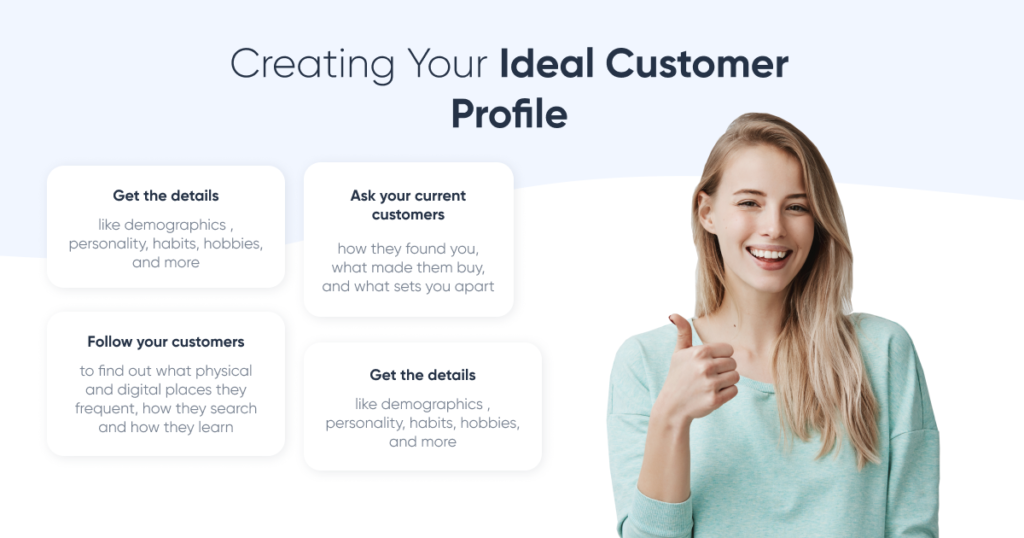
What do they need vs what do they want from you?
What they need can encompass a broad range of aspects. Essentially, your customers and clients are those who need what you have to offer. However, they want more from you than merely the product you sell.
Demands have changed in the past decade. Customers demand streamlined purchasing processes, convenience, trustworthiness, good service, and respect. There are even customer requirements for social responsibility, sustainability, animal cruelty prevention, and so much more. They might not be absolute necessities to a specific purchase, but customers will choose a company that gives them these things over a company that doesn’t. Often at greater expense.
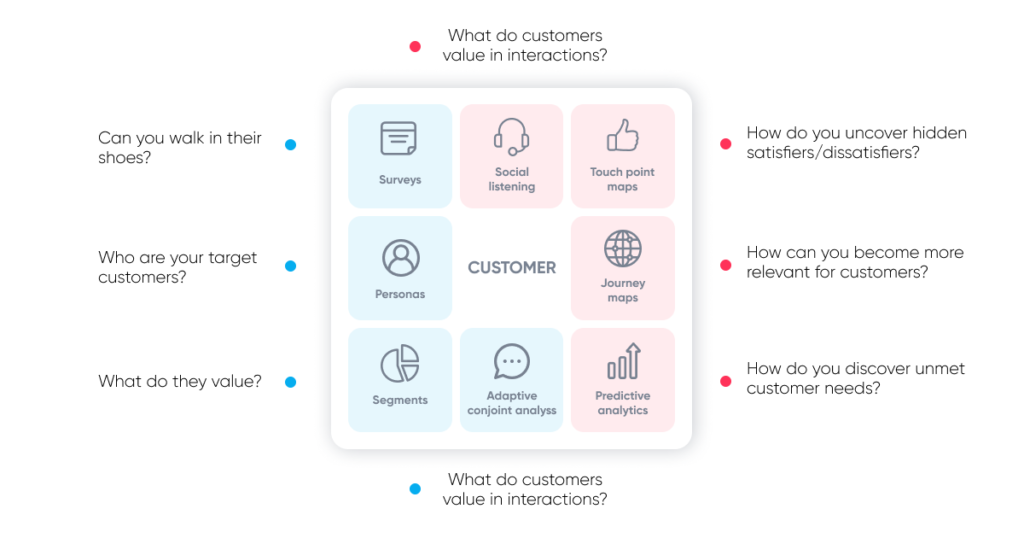
When do they want you?
When clients desire products or services is just as important as what they want. If we’re talking retail, it’s a case of when you can deliver. For services, when they need you. Another core component of time is that you want to know when people are most likely to search and find your business. When does your webpage get the most visits? When is your busiest time?
What does their customer journey look like, from beginning to end?
This is important to your business because you need to understand your customer’s path to becoming a paying customer. Optimising aspects of your marketing and support will drive customers to convert. The image below is a basic representation of the customer journey, and you can use the fundamental structure and customise it to your business.
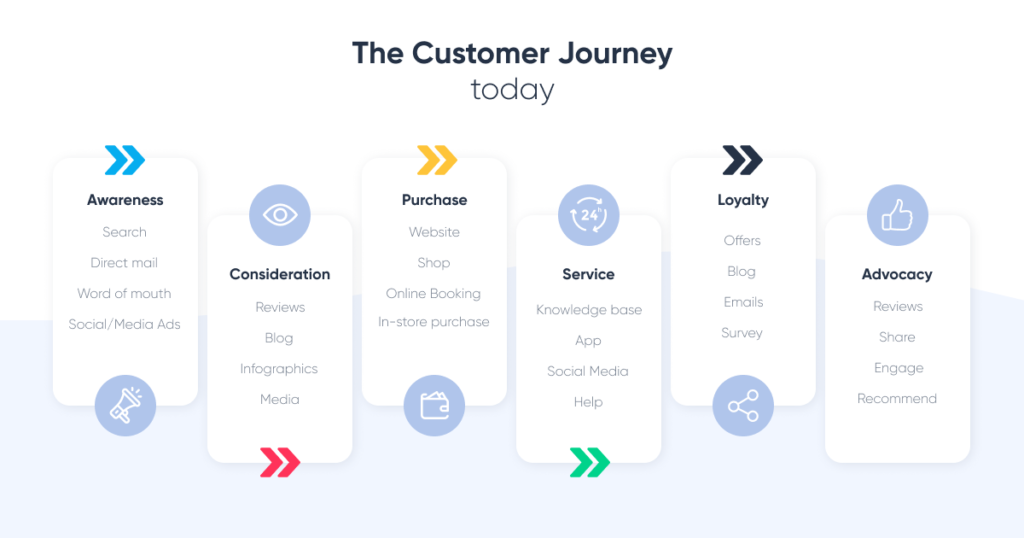
Which channels are they using to reach you?
Search, Ads, Social Media, Website, ChatBot, email; the list goes on. The channel you want to focus your efforts on will stem mainly from your customer action tracking and who your customers are (or who you’re trying to target).
If your target audience for either products or services is the over 60s, you will have far less luck using newer social platforms and chatbots than if you were targeting the under 30s. Choose the best access points to target your specific demographics and begin to pull them together in a unified customer experience. Utilising the CX platform is an effective way to enhance your customer experience.
How can you seamlessly integrate channels?
You can use dozens of tools to effect a multichannel approach to marketing and customer service. Still, for omnichannel, you need a central customer relationship management (CRM) system to pull together all channel access points. Most of the software you might use to track your marketing efforts, grow your subscriber lists, manage your sales and schedules etc., also have API integration to a central management system. Alternatively, if you have a smaller business, the skilful use of something like Zapier can help you manage input from your multiple channels into a single reference point.
Depending on the size of your business, and the customers you are trying to engage, there are three major centralised systems you can use for sharing information between channels:
- DMP – Data Management Platform
- CDP – Customer Data Platform
- CRM – Customer Relationship Manager
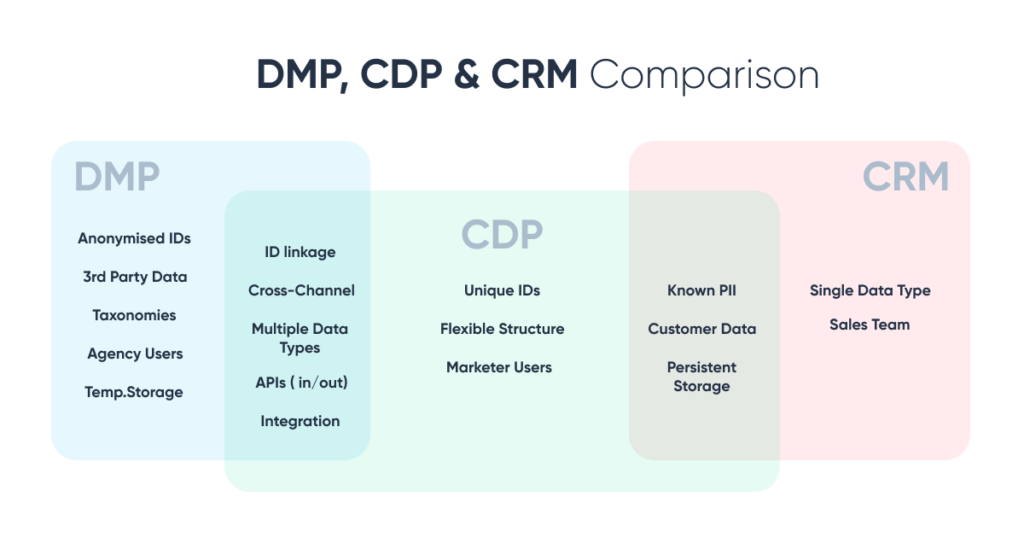
Omnichannel Best Practices
There’s no one way to implement an omnichannel strategy. The specific methodology you use to put your clients in your business’s centre must be tailored to your clients, your product, your services, and obviously your customers. However, conversely, some best practices will always be a part of the omnichannel customer experience.
Excellent mobile services
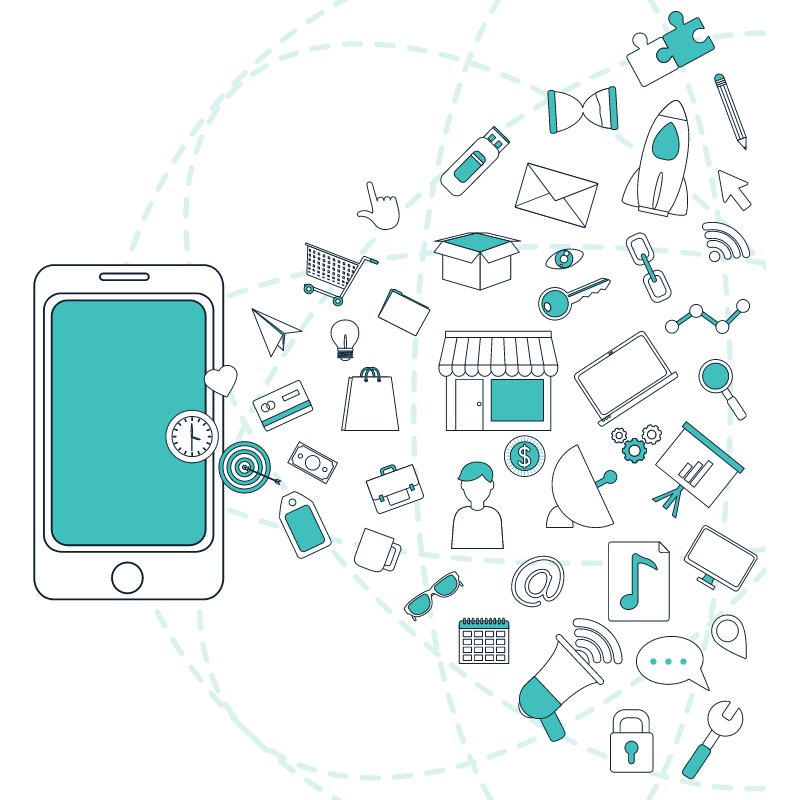
Whatever you do to create an omnichannel customer experience, mobile service must be a top priority. According to one study, up to 87% of customers buy products or book services through their mobile phone. That’s a massive number to think about. If so many people use their phones for purchasing and booking, they probably also want to use them for customer service purposes. However, a significant number of respondents in the original survey also said that mobile customer service was severely lacking.
Social media response

How quickly can you respond to your social media followers? The thing with social media is the immediacy of it. The reason people tweet their service providers and retailers is so they can get an instant response.
It doesn’t always work, but if you can get your social responses down to 60 minutes or less (during normal working hours), you will find people are far more complimentary about your services. Moreover, social media’s public nature will show others how well you deal with queries and complaints. More and more companies are employing social media channels are a critical part of customer service.
SMS crosses industries

People can block push notifications from apps as standard (I’m not the only one who does it); essential and valuable information via text is significantly more immediate and engaging for clients.
Unless you use SMS for every little message, including blanket marketing shots, people are much more likely to pay attention to SMS messages, not least because SMS isn’t free. Email and push notifications are free, and you can use them to reach customers with very little expenditure. However, if you are willing to spend money on telling your clients something important, they are more likely to agree that it’s important.
Self-service & Self-help
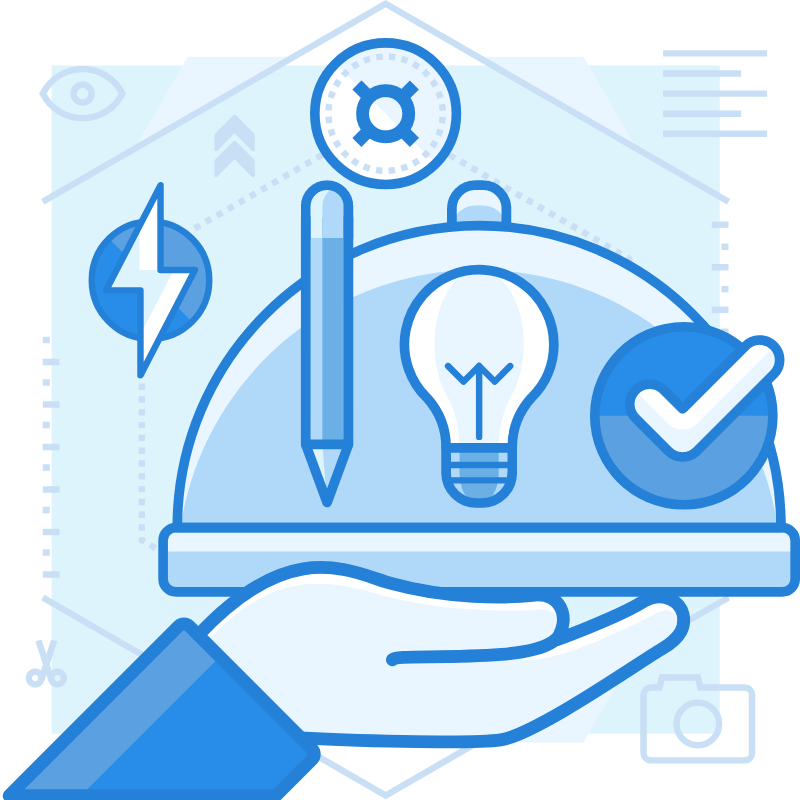
The quickest route to getting answers is to look for them yourself. Quite rightly, customers have learned not to get caught in the trap of entering dialogue when there is a possibility of getting railroaded into buying or booking. An old sales technique that worked briefly in the past has made many people wary of contacting companies directly – if they can find the information themselves.
Here, you need to ensure that self-help and frequently asked questions are optimised across channels. Keep FAQs up to date, ensure mobile optimisation, be proud of your company goals and ethos.
People prefer to research things with their own agenda instead of engaging with customer service before buying or booking. Like people research different service providers and retailers with the best deals, searching FAQs and business practices is part of that process.
Live Chat

Whether your on-screen live chat connects to a real person or an AI-powered chatbot, it’s one way that people can engage with your online services instantly. It has become common to see a live chat button in the corner of a screen, easy access to the answers your clients need.
A word of warning, it’s easy to spot the AI-powered chatbots because they start talking as soon as you’ve been on the page for a certain amount of time. That’s not to say chatbots don’t have their uses. They can fill gaps in customer service availability by answering more basic queries or at unserviced hours.
Another benefit of live chat is that is can help cross language barriers for international companies with the careful use of translation software.

We can’t get past email marketing and contact as a crucial aspect of omnichannel marketing. A considerable number of people still use email to get in touch with their service and retail providers. It is the most comprehensive medium through which businesses can convey complex ideas and complete information. Conversely, it allows customers to make queries, add attachments, images, and even track mail receipt. Email is a beautifully direct and reciprocal method of reaching existing and lapsed customers and engaging new customers through growth marketing.
Continuity

It’s not all about the service you can provide via your different channels; it’s also about how your customers see you. A physical store should translate its in-store experiences and themes to the website, apps, print and display ads. With recent technology developments, it’s now easier than ever to translate a website experience into a mobile app, copying themes and data across.
Tracking Customer behaviour and interactions between channels
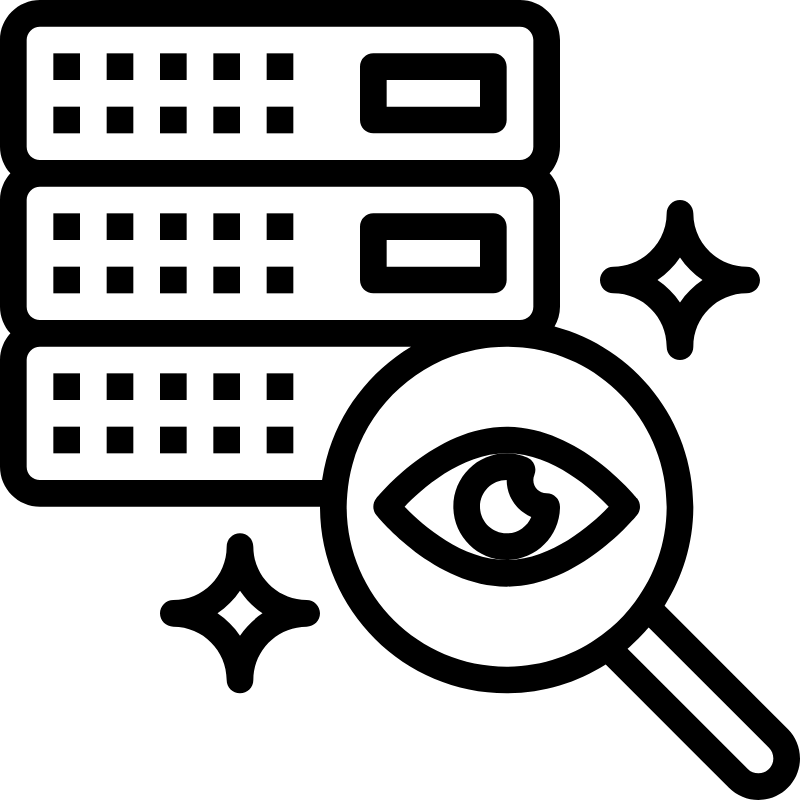
As part of defining your customer journey and who they are, you will need to monitor the different channels you have available to them. With an omnichannel strategy, you will need to update and track the channels your customers use frequently.
To maintain a functional and effective omnichannel experience for your clients, you need to keep up with ever-changing customer habits. This means keeping up with your existing clients as well as the channels your potential clients use too.
Customer feedback is essential to tracking the efficacy of your business touchpoint access.
Empathy: Your link with all the customers

Use your own experiences with customer service and treat all customers as you want to be treated by others. Unless we are blessedly fortunate, we have all experienced terrible customer service at some point. The question that will define how you treat your clients is,
“Would I wish that on any of my customers?”
It’s impossible to please everyone all of the time. However, are you going to strive to be better than the rest, or will you repeat the cycle of terrible customer experience? No matter what your business, you are also someone else’s customer. You can always associate your experiences with those of your customers and plan to be better.
Testing the system
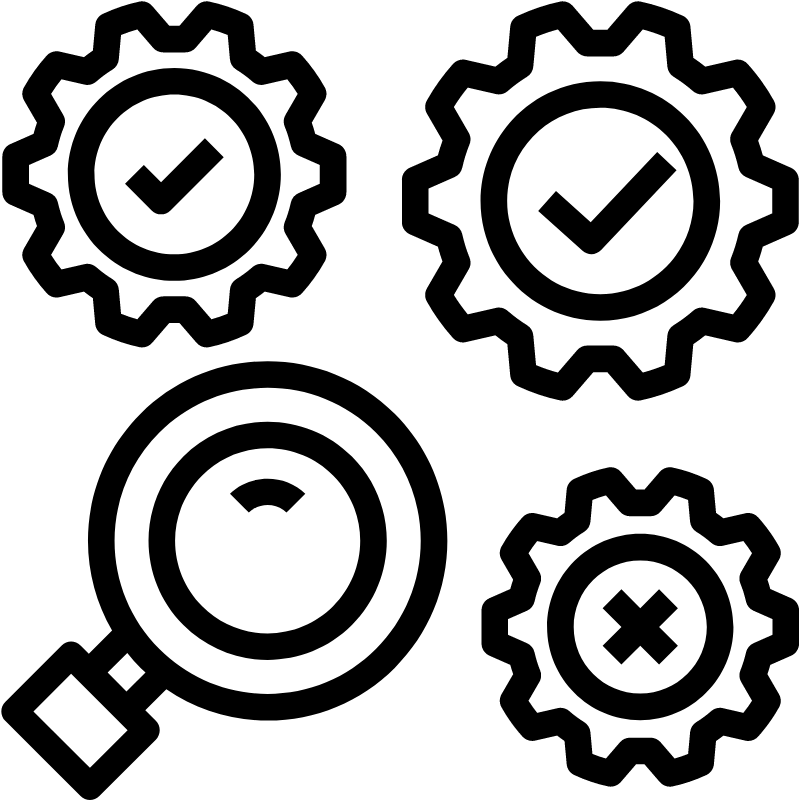
There is not a single cut-and-dried system for creating an omnichannel customer experience. When you start introducing your integrated service and access system, you will need to test it out. With careful planning and research, you might have the beginnings of an excellent omnichannel strategy. However, it’s worth investing in customer research to see how your customers receive and experience the changes you have made. It will be easier to find and tweak any problems early on with the new data from your customer feedback.
Examples of Good Omnichannel Experience Companies
It has been a long learning curve, but most business managers accept that an omnichannel strategy is crucial. Otherwise, they risk losing out to their competitors. The companies that have succeeded over the past decade’s technological advancements have a significant grounding in customer-centric practices. Moreover, they have implemented seamlessly integrated communication between channels.
As expected, some companies have done better than others. Below are some names you might know that are excelling at the omnichannel customer experience.
Asos –
Despite a lack of physical stores, they have an excellent approach to multichannel marketing and outstanding integration access. The critical motivator is that Asos understands its customers’ needs and desires. All of which brings those channels together into an omnichannel customer experience.
Amazon –
Amazon has a fantastic approach to customer-centricity, localisation, and omnichannel marketing, digital and customer experience. Though some customers might have less-than-warm feelings towards the massive international retailer, Amazon has built its reputation and provision with customer desires as their driving force.
Nike –
Concerning their online sales through Nike.com, they have a fantastic omnichannel customer experience. Through collaboration with their retail partners, they also promote and extend their omnichannel approach to ensure customer get the same excellent customer journey. No matter if it’s direct to the customer or through a retail partner.
John Lewis –
Well-known in the UK for their much-anticipated Christmas ads. However, they were also one of the first British retail chains to approach the concept and implementation of the omnichannel experience.
You might notice that all of these companies are retail giants in their own right. However, that’s not to say that omnichannel isn’t just as necessary for the service sector – if not more so. We know that correlation doesn’t always equate to causation. However, these companies have become and stayed well-known by putting their customers at the centre of their business development.
Print & Display Media In Omnichannel Marketing
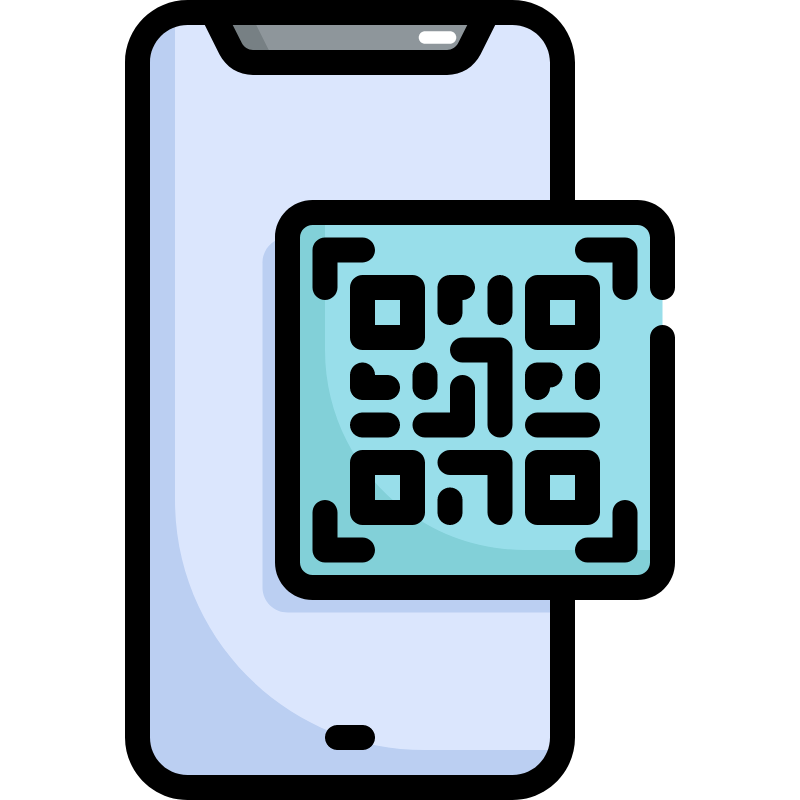
Many people wonder how they can incorporate non-digital channels in their omnichannel approach to marketing and client engagement. It could be print or display ads, or it could be the in-store experience. For brick and mortar experiences, many companies use the loyalty scheme to integrate the physical and digital. Not only do “loyal” customers and clients get preferential treatment and offers, but the business can also incorporate the buying process with their online systems, which has become critical in the past 12 months.
In print and display advertising, digital incorporation has become innovative. There have always been trackable codes for discount coupons, but what about that massive billboard? While not taking off as much as expected in the early 2000s, QR codes became significantly more common in China and South Korea. However, since the Apple iOS update in 2017, which made QR scanning a native application, they have become significantly more widely used worldwide. With the COVID-19 pandemic and the need for contact-free interaction, QR codes are seen almost everywhere, from invoices to restaurant menus and food packaging.
Who saw the billboard and scanned the QR code? Track the interaction with the code.
Data Protection in Omnichannel Systems

One thing you must address when using client information to provide an omnichannel customer experience is data protection. You had better be sure that you have it. More countries are being super careful about their citizens’ data privacy, so laws are being enacted to provide legal protection. If you can’t say you’re doing everything you can to safeguard your clients’ data, you might find yourself unable to work in some countries.
Documented security protocols and policies within the framework of many countries data protection laws are usually ample from a legal standpoint. While there is no requirement to guarantee data security (no one can do that), operating your data collection process within the required guidelines is critical. When you have data communication along various channels, it is so much more important to ensure you have the appropriate security in place because there are so many more ways that data can be hacked or manipulated.
Compliance with GDPR in the EU and state-specific privacy laws in the US (and wherever you want to do business) is a key determining factor for many customers. Remember that the customer is the key.
Omnichannel Customer Experience – An Essential for Every Business
Omnichannel customer experiences rely on a single core premise – The customer is the business’s focus. The driving force behind all product and service developments should stem from the customer’s needs, wants, and evolving requirements.
An interesting comment on Linkedin reminded me of a customer-centric business model’s fundamental building bricks. While the initial thread was about balancing ambition and self-love, an astute commenter observed that the same applies to businesses. A company should be ambitious but shouldn’t risk “falling in love” with itself. When the company ego becomes more important than the customer, the customer loses faith in the company.
Customer-centricity and omnichannel customer experience go hand-in-hand. Omnichannel is often depicted as an encompassing circle of overlapping and connected channels, with the customer at the centre. While omnichannel is considered the best business strategy for engaging, persuading, and retaining customers, the customer is the model’s driver. Sure, your business significantly benefits from the omnichannel strategy, but your customers (past, present, and future) determine what you need to do to achieve it. Their feedback on the omnichannel customer experience you create is your benchmark of success.
Our particular thanks to Dr Edda Blumenstein at beOmni.is for her expertise and insights into the world of omnichannel customer experience.



Comments
1 comments